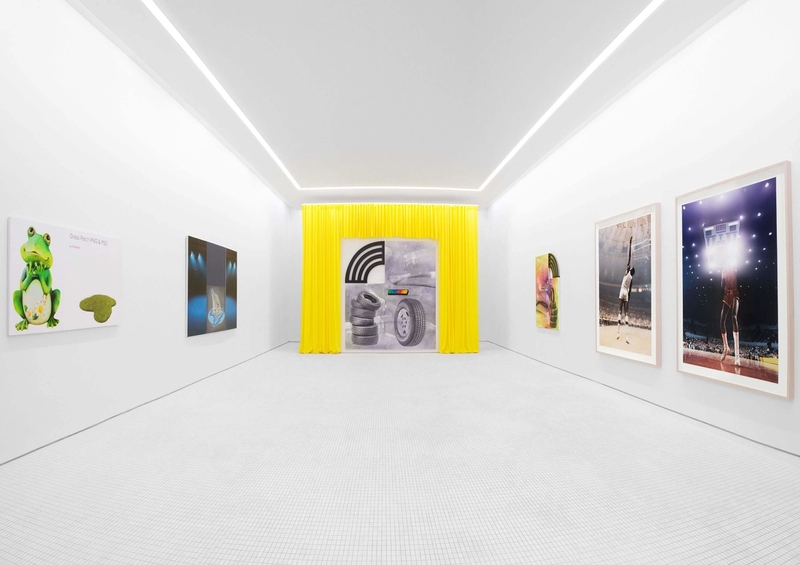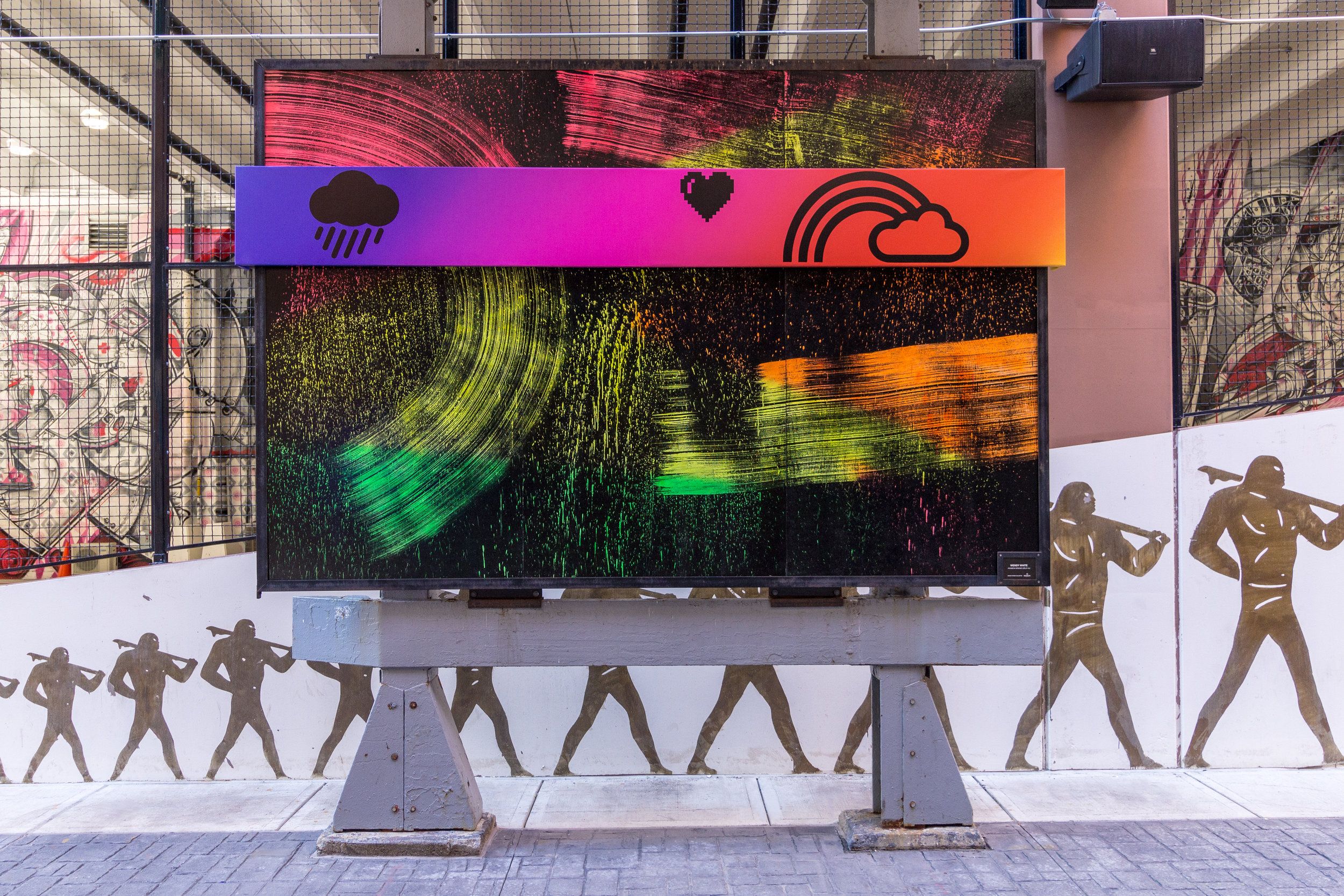
Press Release

Through the lens of the American stage, Fade to Fade challenges the passivity of our contemporary self-image at a time when manipulation through social and news media has reached dizzying heights. Through the deconstruction of pervasive imagery within media and popular culture, artists Julia Wachtel, Paul Pfeiffer, and Wendy White present a dismantling of the pageantry of commerce, performance, and policy to reveal the axioms and essential flaws that lie beneath.
Julia Wachtel rose to prominence in the 1980s after the ascent of the Pictures Generation of artists, who worked within the self-reflexive and critical principles of Minimal and Conceptual art, but with a return to recognizable imagery. These artists explored the way in which images shape our perceptions of ourselves and the world, and Wachtel took the analysis further by dissecting the process of image-making through the seclusion, pairing, and repetition of high and low forms of media. This fragmentation and isolation challenges the viewer to recognize how disparate symbols, psychologies, and emotions are packaged within popular culture and news media for easy consumption by the public. While her process of dismantling originated at a time where TV was the primary vehicle for our reception, Wachtel’s practice has grown and changed over the years along with the new mechanisms and technologies that inundate us. Her cast of characters, vocabulary, and concerns have been reworked within paintings that address much of what continues to consume us: war and protest, politics as entertainment, corporate greed and environmental negligence, celebrity culture, and conspicuous consumption itself. Wachtel’s works within Fade to Fade use clip art and stock imagery culled from image searches referencing the natural world; where she once sourced cartoon imagery from greeting cards and advertisements, clip art provides a similar function within the work: “It is not always a cartoon; it can be anything that functions as a placeholder for the position of subjectivity.” For the artist, these uncultivated images provide a utilitarian value, where characters become “witnesses reflecting the existential condition of exposure to the global reality of horror and deprivation that exists somewhere on earth all the time.”
Paul Pfeiffer is a sculptor, photographer and video artist whose works underline the spectacle at work in media, sports and entertainment. Central to his work and visible across mediums is the practice of editing and erasure, where people, objects, and sounds are removed from their original context in order to bring focus to heightened emotion and the constructions of performance. “My understanding of what being an artist is is very connected to editing. In editing you are anticipating the reception of things in the mind of your viewer. You’re playing on a psychological level with manipulating perception,” says Pfeiffer. He says that historically, editing was considered “almost alchemical or shamanistic, the possibility to create perception for other people without them even realizing it’s happening.” In this way, the same tools used by media are employed within his art to expose them, and Pfeiffer sees the accessibility of these processes as “apocalyptic”, where everyone has access to the tools of the magician to create manipulations of oneself or others. The artist’s two photographic works within the exhibition are from his ‘Four Horsemen of the Apocalypse’ series, where singular basketball players occupy the center of each frame, their competitors, advertising logos, and the ball itself removed from the imagery. The figure is suspended in action and surrounded by spectators, and Pfeiffer’s nuanced control of the image conveys remarkable power.
Wendy White is a multimedia artist and painter concerned with the dismantling of cultural semiotics for a subsequent reconstruction that is simultaneously fractured and insightful. White employs symbols of American culture - advertising, sport, and the mark making and graffiti of the urban environment - to explore the motivations behind the production of these images, which she sees as a deeply human desire for acceptance and recognition. In parallel, she recalls the language of twentieth century painting as a reference to other male-dominated disciplines and modalities that are revealed within the work. Like Pfeiffer and Wachtel, her paintings extract the relationships between the deviating–or even opposing– symbols and behaviors in which they participate. White’s canvases in Fade to Fade share a similar fragmentation in their composition to Wachtel’s, but though her images of Uniroyal tires are fixed on particular panels, her gestural marks extend across multiple supports and lend an intentional physical connection. Both works include dibond rainbows that lend further unity between elements and act as bridges; White uses them as reference to symbols from Norse Mythology, where these fleeting and atmospheric natural wonders signify a passage from earth to the realm of the gods. In creating them in the language of iconography, they read as tropes of marketing, wayfinding or consumption. The stack of tires within the works read as a reference to auto shop commodities, alluding to a male-dominated car culture and also relevant within the city of Detroit, where an 80 ft Uniroyal tire (made to house a ferris wheel for the 1964 World's Fair) remains on display along the I-94.
Evident within the isolation and magnification of the constituents of media spectacle, Fade to Fade acts as a collaborative exposure of the mechanisms at work behind an ever-intensifying and pervasive media presence in our lives. White includes a stage curtain framing one of her works on the central wall within the exhibition, adding another layer in reference to this mythical stage of the American cultural landscape. Although the works of Wachtel, Pfeiffer, and White may suggest critique, each artist is deeply aware of their own indoctrination and anxiety around the ‘decline of future’. As Pfeiffer says, “I hope in the bigger picture I’m contributing to dialogues in general, even if in a way that might seem contradictory. The problem with critique is that it assumes a critically distant position. That doesn’t hold water for me. I want to participate in keeping a certain kind of vanguard platform open around language, and around the higher forms of communication and exchange. They are so precious.”
Fade to Fade, on display from April 10 through May 8, 2021.
Install Images



Artwork Images

Julia Wachtel
Habitat v.1 (dolphin), 2020
Oil, flashe, and acrylic on canvas [3 panels]
60h x 92w inches

